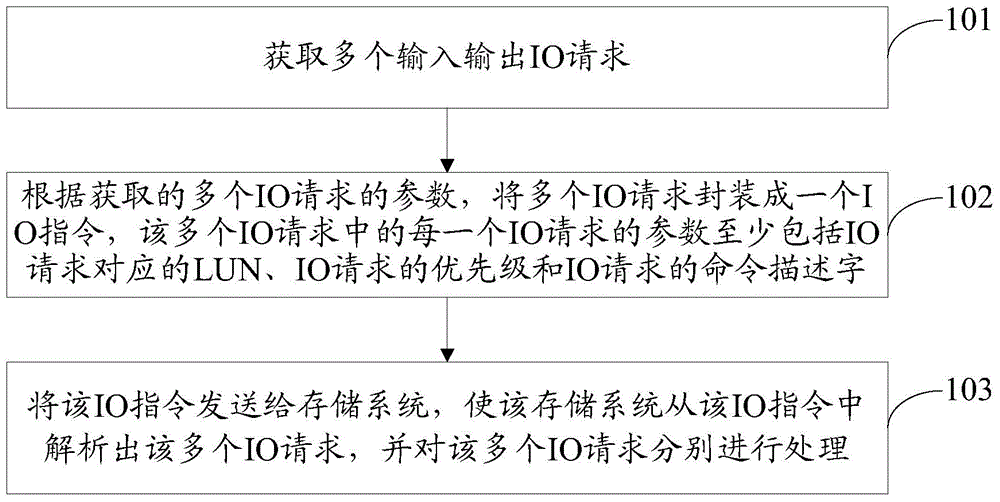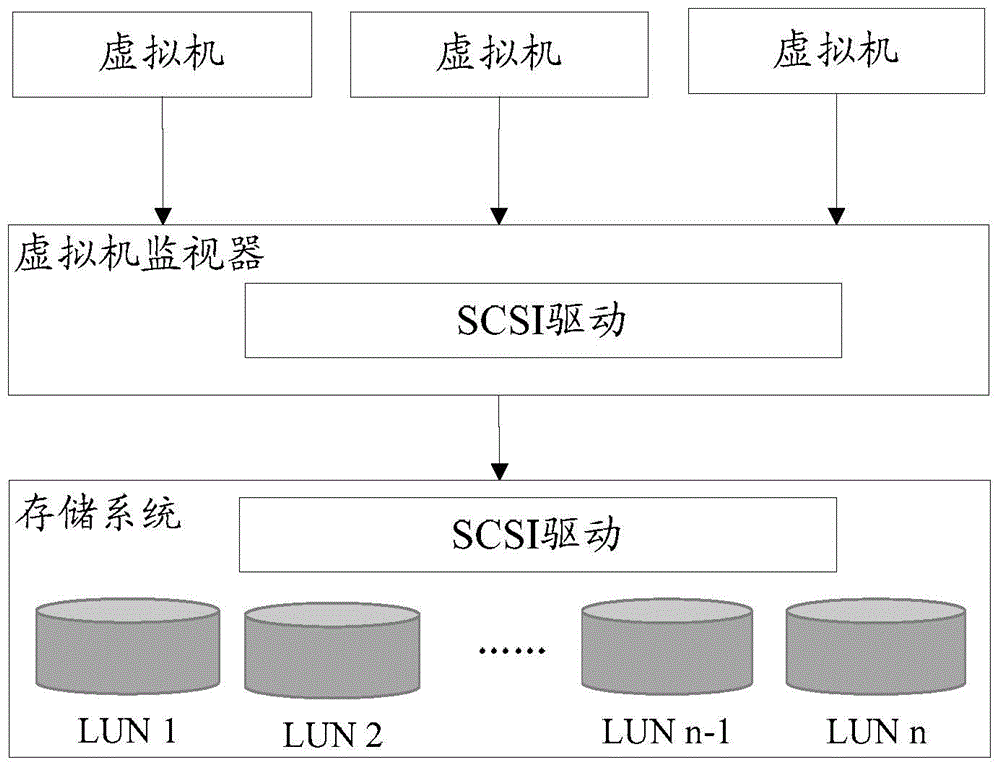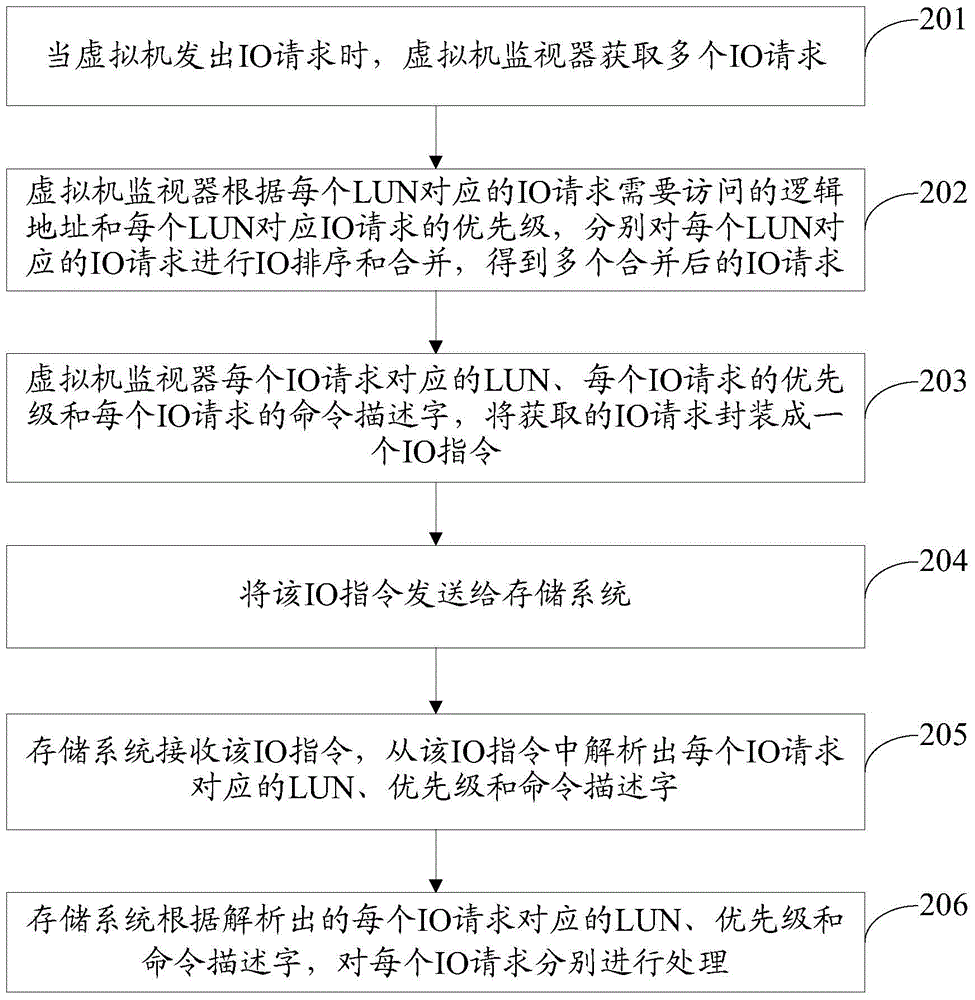Method and device for processing input and output requests
A technology of input and output requests and input and output, applied in the computer field, can solve problems such as the inability to do IO request IO sorting and merging, reduce the read and write performance and throughput of the storage system, and the inability to do IO request sorting and merging, etc.
- Summary
- Abstract
- Description
- Claims
- Application Information
AI Technical Summary
Problems solved by technology
Method used
Image
Examples
Embodiment 1
[0080] The embodiment of the present invention provides a method for processing input and output requests, see figure 1 , the method includes:
[0081] Step 101: Obtain multiple input and output IO requests;
[0082] Step 102: Encapsulate the obtained multiple IO requests into an IO command according to the obtained parameters of the multiple IO requests, and the parameters of each IO request in the multiple IO requests include at least the LUN corresponding to the IO request and the Command descriptors for priority and IO requests;
[0083] Step 103: Send the IO command to the storage system, so that the storage system parses out the multiple IO requests from the IO command, and processes the multiple IO requests respectively.
[0084] Wherein, according to the obtained parameters of the multiple IO requests, the multiple obtained IO requests are encapsulated into one IO instruction, including:
[0085] Fill the LUN corresponding to each IO request in the LUN field of the ...
Embodiment 2
[0113] An embodiment of the present invention provides a method for processing input and output requests. Among them, see figure 2 As shown in the structural schematic diagram of processing input and output requests, the system includes a virtual machine, a virtual machine monitor and a storage system, the virtual machine monitor and the storage system respectively include SCSI driver modules, and the storage system also includes multiple LUNs. Wherein, one virtual machine corresponds to one or more LUNs.
[0114] see image 3 , the method includes:
[0115] Step 201: when the virtual machine sends an IO request, the virtual machine monitor obtains multiple IO requests;
[0116] Further, when the virtual machine sends out an IO request, the virtual machine monitor can obtain multiple IO requests within a preset time period.
[0117] Wherein, the IO requests obtained by the virtual machine monitor within the preset time period may be requests sent by one virtual machine, o...
Embodiment 3
[0160] The embodiment of the present invention provides a method for processing input and output requests, see Figure 4 , the method includes:
[0161] Step 301: when the virtual machine sends an IO request, the virtual machine monitor obtains multiple IO requests;
[0162] Further, when the virtual machine sends an IO request, the virtual machine monitor obtains multiple IO requests within a preset time period;
[0163] Wherein, the IO requests obtained by the virtual machine monitor within the preset time period may be requests sent by one virtual machine, or requests sent by multiple virtual machines.
[0164] Since a virtual machine corresponds to one or more LUNs, the IO request sent by the virtual machine can be a request to multiple LUNs, or a request to the same LUN.
[0165] Wherein, in the embodiment of the present invention, the IO request may be issued by a virtual machine, a personal computer, or a clustered server system, so the embodiment of the present inven...
PUM
 Login to View More
Login to View More Abstract
Description
Claims
Application Information
 Login to View More
Login to View More - R&D
- Intellectual Property
- Life Sciences
- Materials
- Tech Scout
- Unparalleled Data Quality
- Higher Quality Content
- 60% Fewer Hallucinations
Browse by: Latest US Patents, China's latest patents, Technical Efficacy Thesaurus, Application Domain, Technology Topic, Popular Technical Reports.
© 2025 PatSnap. All rights reserved.Legal|Privacy policy|Modern Slavery Act Transparency Statement|Sitemap|About US| Contact US: help@patsnap.com



